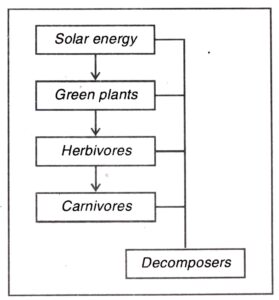SEBA Class 7 Science Chapter 1 Nutrition in Plants – Textbook Solutions & MCQ
Get Class 7 Science Chapter 1 “Nutrition in Plants” Solutions for SEBA Assam (English Medium) students. This chapter explains how plants produce their food through photosynthesis, different modes of nutrition, and the importance of nutrients in plant growth. Our solutions provide detailed NCERT/SCERT textbook answers, important MCQs, and key explanations to help students build a strong foundation in science. These solutions are designed to enhance concept clarity and exam preparation.
Class 7 Science
Chapter – 1 Ospin Academy
Nutrition in Plants
EXERCISE
Q.1. Why do organisms need to take food?
Ans: Food is needed by all organisms for the following purposes:
(i) The main function of food is to help in growth.
(ii) Second important function of food is to provide energy. We need energy for doing physical work. We use more energy when we run than when we walk and less energy when we sleep.
(iii) Food is also needed by living beings for replacement and repairing their damaged body parts:
(iv) Food gives us resistance against diseases and protects us from infections.
Q. 2. Distinguish between a parasite and a saprotroph.
Ans:
|
Parasite |
Saprotroph |
|---|---|
|
1. Parasite feeds on a living organism. |
1. Saprotroph feeds on dead and decaying organism. |
|
2. The organism on which it feeds is called host. |
2. They do not feed on a living organism. |
|
3. A parasite takes readymade food from the organism on which it feeds. |
3. They secrete digestive juices on the matter they live and convert it into a solution and then absorb it. |
Q. 3. How would you test the presence of starch in leaves ?
Ans: Starch test:
(i) Take the green leaf to be tested.
(ii) Boil it in water for 5 minutes.
(iii) Keep it in the 60% ethyl alcohol at 60°C, till it becomes colour less.
(iv) Take out the colour less leaf from alcohol and wash it with cold water.
(v) Pour few drops of dilute iodine solution on the leaf. The leaf becomes blue with the solution which proves the presence of starch in the leaf.
Q. 4. Give a brief description of the process of synthesis of food in green plants.
Ans: The green plants have chlorophyll in the leaves. The leaves use CO2, and water to make food in presence of sunlight.

During photosynthesis oxygen is released.
Q.5. Show with the help of a sketch that the plants are the ultimate source of food.
Ans:

Fig. 1.9. Sketch to show that plants are the
ultimate source of food.
Q. 6. Fill in the blanks:
(a) Green plants are called _______ since they synthesise their own food.
Ans: (a) autotrophs.
(b) The food synthesised by the plants is stored as ________.
Ans: (b) starch
(c) In photosynthesis solar energy is captured by the pigment called ________.
Ans: (c) chlorophyll.
(d) During photosynthesis plants take in _______ and release _________.
Ans: (d) carbon dioxide, oxygen.
Q. 7. Name the following:
(i) A parasitic plant with yellow, slender and tubular stem.
Ans: (i) Cuscuta (Amarbel).
(ii) A plant that has both autotrophic and heterotrophic mode of nutrition.
Ans: (ii) Pitcher plant.
(iii) The pores through which leaves exchange gasses.
Ans: (iii) Stomata.
Q. 8. Tick the correct answer:
(a) Amarbel is an example of:
(i) Autotroph
(ii) Parasite
(iii) Saprotroph
(iv) Host
Ans: (a) (ii) Parasite.
(b) The plant which traps and feeds on insects is:
(i) Cuscuta
(ii) China rose
(iii) Pitcher plant
(iv) Rose
Ans: (b) (iii) Pitcher plant.
Q. 9. Match the items given in Column I with those in Column II:
|
COLUMN – I |
COLUMN – II |
|---|---|
|
(a) Chlorophyll |
(i) Bacteria |
|
(b) Nitrogen |
(ii) Heterotrophs |
|
(c) Amarbel |
(iii) Pitcher plant |
|
(d) Animals |
(iv) Leaf |
|
(e) Insects |
(v) Parasite |
Ans:
|
COLUMN – I |
COLUMN – II |
|---|---|
|
(a) Chlorophyll |
(iv) Leaf |
|
(b) Nitrogen |
(i) Bacteria |
|
(c) Amarbel |
(v) Parasite |
|
(d) Animals |
(ii) Heterotrophs |
|
(e) Insects |
(iii) Pitcher plant |
Q. 10. Mark T if the statement is true and ‘F” if it is false:
(i) Carbon dioxide is released during photosynthesis.
Ans: (i) False.
(ii) Plants which synthesise their food themselves are called saprotrophs.
Ans: (ii) False.
(iii) The product of photosynthesis is not a protein.
Ans: (iii) False.
(iv) Solar energy is converted into chemical energy during photosynthesis.
Ans: (iv) True.
Q. 11. Choose the correct option from the following:
(a) Which part of the plant takes in carbon dioxide from the air for photosynthesis?
(i) Root hair
(ii) Stomata
(iii) Leaf veins
(iv) Sepals.
Ans: (ii) Stomata.
(b) Plants take carbon dioxide from the atmosphere mainly through their:
(i) Roots
(ii) Stem
(iii) Flowers
(iv) Leaves
Ans: (iv) Leaves.
Q1: What are the different types of nutrition in plants?
Plants have autotrophic and heterotrophic nutrition. Autotrophic plants make their own food through photosynthesis, while heterotrophic plants depend on other organisms for nutrients.
Q2: How does photosynthesis work in plants?
Photosynthesis is the process where plants use sunlight, carbon dioxide, and water to produce glucose and oxygen. The green pigment chlorophyll helps in capturing sunlight.
Q3: Why is “Nutrition in Plants” an important chapter in Class 7 Science?
This chapter builds the foundation of plant biology, explaining how plants sustain themselves and support life on Earth by producing oxygen and food.
Q4: Where can I find Class 7 Science Chapter 1 solutions for SEBA Assam?
You can find detailed textbook solutions, MCQs, and explanations for SEBA Assam Class 7 Science Chapter 1 on this page.
Q5: Where can I find solutions for all Class 7 Science chapters?
To get solutions for all Class 7 Science chapters, Click Here

